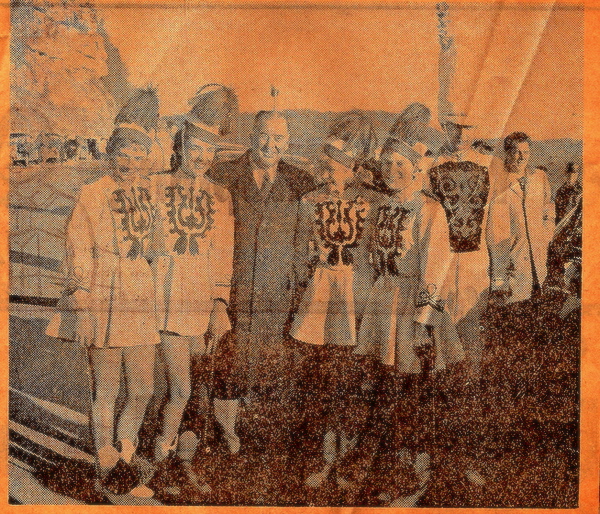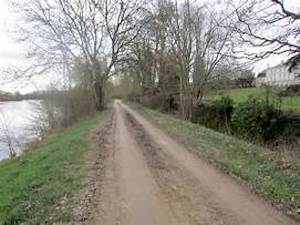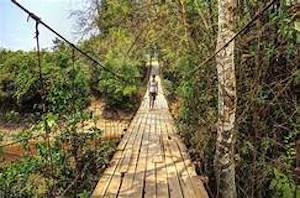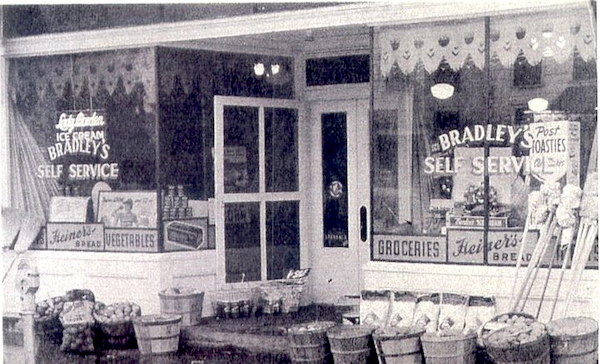Corduroy Roads, Bridges and Things
People my age made it into the world at just the right time. We saw amazing changes in every areas of our lives. The things of nineteenth century was fading away and the twentieth was struggling to take hold. In retrospect, during my early years my view of the world was narrow, as it should be for a kid. I did get to see many of the old ways that became lost and totally foreign to the generations that followed. Consider that the nation had just gone through two world wars and a deep, world-wide depression that had all but destroyed the American dream for the general populace. Things couldn’t have been any more uncertain for those who were trying to settle down and raise their respective families. I dream of owning their own home and land to cultivate was destroyed along with the economy. The ‘Dust Bowl’ didn’t help either, when crops was destroyed and families lost it all.
When I was growing up I some of the things that became part of the recovery. There were plenty of ‘modern’ advances except during the war years that followed. For the most part these were merely ‘how things were’ to me. Throughout these years I suffered though the deprivations common at the time. I have to confess that I really didn’t know if I was poor, or rich. It didn’t matter. Children tend to not see the problems, but we are keen to pay attention when we see grownups excited over something. For me, the worries the older folks had to carry were theirs, so long as I had something to eat and was allowed to play. My life was about friends, toys, eating, and playing.
When I was young, the little town was full of trucks and automobiles that had been made before the war, or only just after. The 1947 models looked much the same as the 1941s. That was because the factories had stopped producing new cars in favor of making tanks, airplanes, trucks and jeeps for the war efforts in the European and Pacific theaters. That was also part of why I still saw Model ‘A’s’ and ‘T’s’ driving about. Of course, many of the people that lived off the land around town were poor and didn’t have the means to buy new cars even if they were available. Financially stressed, many had to watch their pennies, or simply hadn’t gotten around to buying an automobile, whether new or used.
In those days it was common on Saturdays to see horse-drawn buckboards rumble into town to pick up a load of grain or feed. One, resident wagon I remember in particular, delivered ice to iceboxes all around town. It was near the end of the forties when that horse was retired and a flatbed truck took over the ice route. Back then when milk products were delivered a panel truck was used. I don’t remember a horse-drawn milk wagon although I have seen them in movies.
Like cowboys on the big screen, sometimes a lone rider on a good looking horse came into town, rolled his own cigarette, lit up his smoke, and tied his horse to a rail or awning roof support. Mom had already told me to never walk behind a horse, so I always gave it wide berth. I have a vague memory of there being a horse trough downtown somewhere. It goes too far back for me to remember the location. Somehow I think it was near the flower shop, but it may have been across the street at the courthouse. Several of the stores in town had wooden roofs, or awnings over the sidewalk to protect the pedestrians and the crates of produce that were displayed outside the store’s entrance.
Most sidewalks in our town were concrete in my day, one or two still had sidewalks made of wooden planks. That helped me visualize how it was in the old western movies I saw. Our little town at one time may have looked very like those in the western movies with false-front buildings, wooden awnings, horse ties, and buckboards everywhere.
Most of the streets in town were paved by the time I hit them on my trusty bike, but surfaces did vary. I remember a portion of Lock Avenue (between Main Street to Pike) was brick, something I had seen in Huntington, and later in other places. You usually only saw brick streets in big cities.
Of course, our little backwater town was too small to have trolleys, but I did ride them when I attended the eighth grade in Detroit. Later, Detroit took the trolleys out in favor of the more expensive busses. I think that was a conspiracy between bus makers, tire makers, and petroleum interests. Most cities were courted heavily by the bus lobbyists to get rid of those romantic and economical trolleys. Well, all that maneuvering didn’t affect our town since it was tiny enough you could walk anywhere you needed to go in town. Still, for a young, little fellow it was my whole world.
Except for US Highways, many of the roads in Lawrence County were gravel or dirt. When I caught the bus at the drugstore and rode to see my aunt who lived outside Catlettsburg, the road was full of those famous twisty mountain curves that were enough to make this little boy sick. There was no air conditioning in those days and the fumes rushed through the open windows. Yuk!

Meanwhile, the ‘river road,’ (Rt.# 3 back then) didn’t become the main highway north until my senior year. I remember that I was drum major for the LHS band and were sent by bus up that highway to meet with governor Happy Chandler to celebrate the opening of the new road. Gary Smith’s little brother helped the governor to cut the ribbon. He was made a Kentucky Colonel for his efforts. This new road replaced old Rt. #23 that went up the hills to Fallsburg and beyond. It didn’t have a lot of mountainous curves and was much faster and easier to drive than the old road.
Prior to this road being built, I remember far different conditions on that stretch. It was a dirt road, full of deep ruts. It was a common sight to see farmers pulling cars out of the muck. When the driver approached a creek there were no bridges. Cars had to travel down a steep incline where you had to ford the steam. Your success depended on the depth of the mud and current of the stream. Fording was easier when there was a stone bottom, but that wasn’t the case on this soggy trail.
 I remember that there was one or two places where trees had been trimmed and laid down to form what was called a corduroy roadbed. Like the cotton fabric it was named after, there were bumpy aplenty to drive over. One could lose the fillings out of their teeth on some of those bumps! When the logs were wet they could be slick, too. When laid under water they were slick and very difficult to traverse. More than once travelers would slide off and into in mud. I remember spending most of one boyhood afternoon with my aunt trying to get us back up out of a muddy ravine. We ended up having to wait on a tractor to come along to pull us out. For some reason we didn’t have a single cell phone among us! Go figure!
I remember that there was one or two places where trees had been trimmed and laid down to form what was called a corduroy roadbed. Like the cotton fabric it was named after, there were bumpy aplenty to drive over. One could lose the fillings out of their teeth on some of those bumps! When the logs were wet they could be slick, too. When laid under water they were slick and very difficult to traverse. More than once travelers would slide off and into in mud. I remember spending most of one boyhood afternoon with my aunt trying to get us back up out of a muddy ravine. We ended up having to wait on a tractor to come along to pull us out. For some reason we didn’t have a single cell phone among us! Go figure!
Back in those days, lots of farmers still used horse-drawn implements even after they had added a tractor to their shed. It was sometimes easier for them to do it the old-fashioned way. I remember watching sorghum mills run by mules. I think one was out in the Bottom, or maybe out near Beech Grove, or Wallbridge. In any case, it wasn’t far out of town. That sorghum on a hot biscuit mixed with butter was heavenly.
I think you will agree that the swinging bridges were interesting and fairly commonly in use back then. Some families had to cross on foot to get to the family home. This meant leaving their car or truck at the side of the road. Being a perpetual klutz, it was as if the bridges saw me coming. Those evil bridges took me into their clutches and swung me about wildly, even threatening to turn completely upside-down and dump me into the ‘drink.’ Many people had no problems in crossing those horrible conduits, unless of course, one of the older kids purposely started to make it swing. Boys were known to scare girls by doing that. I found from experience that one person can fairly easily cross such a bridge, but when two or more try it at the same time it gets increasingly more difficult. During that time in my life I was a non-swimmer so I envisioned a fall. Splash, it would be a cold death and a soggy trip as my body eventually floated down the Big Sandy, into Ohio River and finally into the great Mississippi. Not the best way to visit the Gulf.
 Unless you think this was a one-time event, let me assure you I’ve seen a number of swinging bridges, either high or low, crossing swollen creeks and deep ravines. Some of them had a wooden floor and ropes to grasp as railing, but some required you to step on crossed sections of rope much like netting. I was instructed to go slow and easy, but my instincts made me want to run. The only answer was to grab hold, hug the cables, and freeze. Surely, someone would save me. Why, oh why did I always have to cross this stupid thing?
Unless you think this was a one-time event, let me assure you I’ve seen a number of swinging bridges, either high or low, crossing swollen creeks and deep ravines. Some of them had a wooden floor and ropes to grasp as railing, but some required you to step on crossed sections of rope much like netting. I was instructed to go slow and easy, but my instincts made me want to run. The only answer was to grab hold, hug the cables, and freeze. Surely, someone would save me. Why, oh why did I always have to cross this stupid thing?
With all these ‘old ways’ still going on it was late in my high school years before we replaced things like our the crank phone to one with a new dial. Then came the push-button models. We had gone from ice box to refrigerators, and had a console TV in our living room. During these busy years of change mankind defeated polio, developed antibiotics, and nearly forgot about TB. The iron lung is long forgotten, yet it saved many lives back in the day. We saw different kinds of heart surgeries and other big advances in medicine.
New, fancy appliances were marketed over TV and housewives gave birthday hints to their hubbies, sometimes accompanied with a favorite meal or some other treat. I remember in the early fifties that the town got its second firetruck. The older one had to be cranked to start. The new one looked ancient today, it was a marvel in its time. I rode on this new one a number of times as a paid volunteer. I’m sure it saved some property and may have saved some lives.
I had already left for military service when a train collided with a fuel truck that resulted in a burst of fire on both sides of the track north on Madison. Burning gasoline ran through the gutters of town and blocked access for volunteers to fight the fire. Sadly, one man his life. A large area of town was destroyed including the depot, frozen food lockers, and some grocery stores and a barbershop. Some people lost their apartments above the stores, too. This changed the face of that part of town that I remember so well.
The confusing thing is that in some ways I have seen important pieces of different centuries. While too young to see the 19th century, I saw some of the horse/buggy period. I lived in the next two centuries and can only be amazed at the changes.
I’ve written stories about the wonderful cold water drawn up from deep wells into oak buckets. Often there was a gourd hanging on a string to use to take a sip. I’ve mentioned camping, riding, and early radio, and TV. But I have also seen a televised picture of a man walking on the moon, a Mars Rover land on the planet and take samples and pictures. We saw the Atom bomb, the World Wide Web, texting, terrorism, a cellphone in every hand. I see a fractured society shaking its head while it wonders what will come next. There are those that think that with the character and fiber of the American people will continue to live in peace. With a strong faith in God we depend on the hope that His blessings will continue to flow. I just hope the road that will take us to a better time is not a corduroy road.













![Foothills-Bundle] Foothills-Bundle](https://thelevisalazer.com/wp-content/uploads/2020/05/Foothills-Bundle-422x74.jpg)






